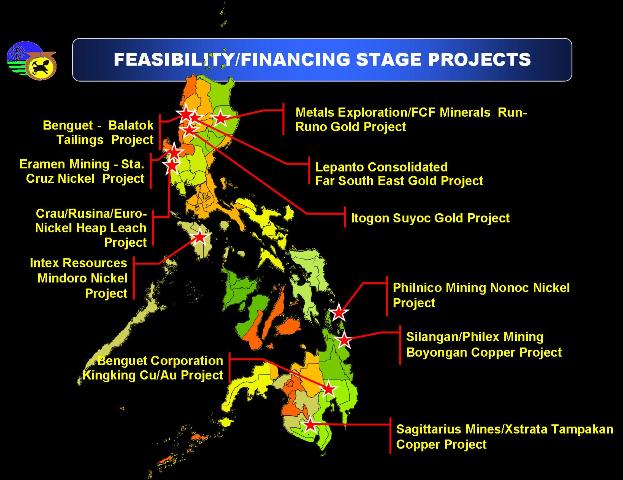Mining In Tampakan
 |
Tampakan, South Cotabato (photo from antipinoy.com)
|
Mineral resources is important for economic growth. Many countries have been extracting their minerals and have done numerous mineral explorations, and established mining operations in other nations to cope up with the market demand. The Philippines is blessed with these mineral resources and various mining companies have invested in the country to extract it.
The Philippines is the fifth mineralized country in the world. With this ranking, it is safe to say that we are rich country in terms of mineral deposits. There are thirty large mining operations in the country. They are all under the Mineral Production Sharing Agreements (MPSAs) entered into the government. According to Benjamin Philip G. Romualdez [1], the President of Chamber of Mines of the Philippines (COMP), the Philippines potential mining wealth is estimated to reach $840 billion (P47 trillion) or 10 times the country's annual gross domestic product. According to their data, the Philippines ranks third in total gold deposits, fourth in copper, fifth in nickel, and sixth in chromite. The country has 8.03 billion tons of copper, 4.91 billion tons of gold, 0.81 billion tons of nickel, 480.26 tons of iron, 39.66 million tons of chromite, and 433.88 million tons of aluminium. Places like Palawan, Surigao, and Tampakan in South Cotabato are abundant with these resources. The mineral resources found in Tampakan is the biggest source of untapped copper and gold resources in Southeast Asia.
areas where mining operates
you can check The Mining Industry of the Philippines for info
Tampakan is a 4th class municipality in the South province of South Cotabato. Its population according to the 2000 census is 33,011. Tampakan has 14 barangays, namely --- 1) Santa Cruz 2) Poblacion 3) San Isidro 4)Maltana 5)Kipalbig 6)Buto 7)Cambayong 8)Liberty 9)Lampitak 10)Pulo 11)Donlag 12)Pula Bato 13)Albagan 14)Tablu. Tampakan is blessed with agricultural and mineral resources such as corn, banana, pineapple, gold and copper, forest products and fiber, woodcraft bamboo and rattan.
 |
| The famous Mt. Susong Dalaga | photo from southcotabatonews.com |
With Tampakan's big deposit of mineral resources, it is no surprise that many foreign investors are eyeing on it. Sagittarius Mines Inc. (SMI), a local company that has global mining player Xstrata Copper, based in Brisbane Australia, and its partner Indophil Resources NL, invested in this multi-billion mining project. It is a $5.9 billion Tampakan Copper-Gold prospect and it is estimated to contain 13.5 million tons of copper and 15.8 million ounces of gold, at a grade of 0.6% copper and 0.2 grams per ton of gold. SMI is looking to begin producing copper and gold at Tampakan by 2016 (3).
 |
| area of mining operation (photo from SMI site) |
There are three types of mining --- Surface mining, Underground mining, and Glory Hole mining. Open-pit or Open cut mining is classified under Surface mining. Open-pit mining is method used primarily for working large mineral deposits. Most open-pit mining requires blasting and the use of heavy machinery, particularly power shovels. Its mining proceeds, a wide and deep pit with step-like side is created. The steps, called benches, serve as platforms for the operation of excavating machines and the loading of tracks or rail cars (4). According to Indophil Resources NL, this type of mining technique is suitable for extraction of big mineral deposit in Tampakan.
 | |||||||
| an example of open-pit mining (photo from lessrain blog) |
Advantages of mining in Tampakan
According to the Junior Chamber International (JCI) Durian City, in a (Business) Inquirer article, mining could:
- Could help spur economic growth in the country by attracting new investments, creating jobs and reducing poverty.
- Mining companies just had to adhere to responsible mining practices that placed great emphasis on environmental protection and preservation and social equity.
- The copper-gold mine was also projected to generate $37 billion in export earnings and 7,000 full time jobs based on SMI data. During the construction period, the project could provide employment to as many as 10,500 people, the majority of them are members of the host communities.
According to SMI, if the Tampakan Project will be approved, the mine would be the largest in the Philippines and among the largest copper mines in the world. The proposed mine site covers an area of approximately 10,000 hectares and is located between the towns of Tampakan, South Cotabato and Kiblawan, Davao del Sur in southern Mindanao. The mine is estimated to yield an average of 375,000 tonnes per annum of copper and 360,000 ounces per annum of gold in concentrate over a 17 year life of mine. [To learn more about the Project, including our mine waste and water management plans, please refer to our Tampakan Project Fact Sheets.]
In an PhilStar article written by Carmen N. Pedrosa, it stated that Tampakan mining project would be the biggest single investment in the country’s history. If all goes well, it would boost foreign direct investments.
Disadvantages of Mining Operations in Tampakan
Environmentalist and other concerned groups are advocating the disapproval of the mining operations in Tampakan. They are aware of its environmental damages and its socio-political implications.
In a study conducted by Robert Goodland and Clive Wicks [5], they said that the (proposed) mining sites are situated in Blaan communities and would also affect its neighbouring municipalities. They said:
“If full-scale operations begin, at least five indigenous communities may be impacted. An estimated 20,000 hectares of sustainable farmlands would be threatened by the environmental impacts of the mining, jeopardizing the food security of the region.”
Furthermore, Goodland and Wicks was also concerned about the mining location. According to Wicks, the mine area is on top of stratovolcanoes and fault lines, some of which cross each other, and is located in an area of high seismic activity, in which SMI plans to build large dams and a rock storage facility for 1.6 billion tons of toxic rock that are highly susceptible to breakage and disasters.
 |
| aerial view of Open-pit Mining in Marinduque (photo from fractions illustrated) |
 |
| Surigao mining (photo from skyscrapercity.com) |
The Center for EnvironmentalConcerns Philippines released the Salient Findings of the Environmental
Investigative Mission (EIM). These are based on the EIM team’s interviews,
focus group discussions (FGDs) and field visits. FGDs were conducted with the
sectors vulnerable to the impacts of mining operations in Columbio
municipality: peasants, irrigators, fisherfolks, women, residents and indigenous
peoples, particularly the Blaan tribe. Interviews were also conducted with
some key local officials.
These are the results:
- Fault lines in Tampakan pose risks to the stability of the mine
- Threat to food security
- False promise of employment and income opportunities
- Militarization and Human Rights Violations
- Displacement of IP communities
Mining in the Philippines has
many complicated issues in the sense that you would only get a headache. The existing
national and local laws with regard to mining overlap each other. If we fail to
learn from other mining operations in the country, we may repeat its disastrous
outcome. As the well tried and tested truism says: those who refuse to learn the lessons of History are doomed to repeat
them.
________________
References:
[1] Business section, Philippine Daily Inquirer: Oct. 22, 2011
[2] Tempest brewing in Tampakan, South Cotabato By Bong S. Sarmiento
http://www.insidemindanao.com/article33.html
[3] Tampakan Mining Dangerous - Experts
manilatimes.net/index.php/sunday-times/thesunday-times-magazines/8453-tampakan-mining-dangerous-experts
manilatimes.net/index.php/sunday-times/thesunday-times-magazines/8453-tampakan-mining-dangerous-experts
[4] New Standard Encyclopedia Vol. IX
[5] Philippines: Mining or Food? Case Study 3: Copper and Gold Mining in Tampakan, South Cotabato – Mindanao Island by Robert Goodland and Clive Wicks for The Working Group on Mining in the Philippines__________________
UPDATE: I am thankful that I was able to talk to different people that link to this issue. I now see the both sides of the story. (06-25-12)
Leave a comment below and let me know what you think.
Thanks.


very alarming! Good job Yadu for sharing this to us :)
ReplyDeleteI'm honored to find my pic in your blog but is saddened to think of the obliteration of this beautiful landscape and the demise of the B'laan culture when mining operation commences.
ReplyDeleteThe second advantage of Mining in Tampakan states that "Mining companies just had to adhere to responsible mining practices that placed great emphasis on environmental protection and preservation and social equity" is an oxymoron, a total BS!
I hope we still have a chance to stop this corporate genocidal giant.
YES YOU ARE RIGHT POBRENG ALINDAHAW.. THEY (SMI) ARE MANUFACTURING LIES FOR PUBLIC CONSUMPTION...
ReplyDeleteKEEP IT UP YADU KARU!!!
Thank you POBRENG ALINDAHAW for reading the article... Yes, we should do something about it before it's too late
ReplyDeletenice one,
ReplyDeleteThanks Mr/Ms. Anonymous for visiting Yadu Karu's Blog ;-)
DeleteIn Mining Industry, Could Life Thrive? What's the use if we have trillions in our bank account, gold reserves, and all the positive economic value...
ReplyDeleteIf all the life form around it no longer exist ?
Who will benefit???
Why are those nationalities digging our lands...and preserve theirs? ? ?
wow! thanks for your comments Maam Luz ;-)
DeleteYes. Who benefits? That is the question. If government is really serious about reducing or eradicating poverty, there are ways to do it without destroying the environment but rather maximize and harness the benefits/potential of a healthy ecology to achieve this objective. Years after you wrote this article and after you revisited Tampakan, I am interested to know your stand on the mining issue. Thank you.
ReplyDeleteYes..I hope I will meet you in person Maam. Nabibitin ako pag online tayo nag uusap. Anyway, thanks for visiting Yadu Karu's Blog ;-)
Delete